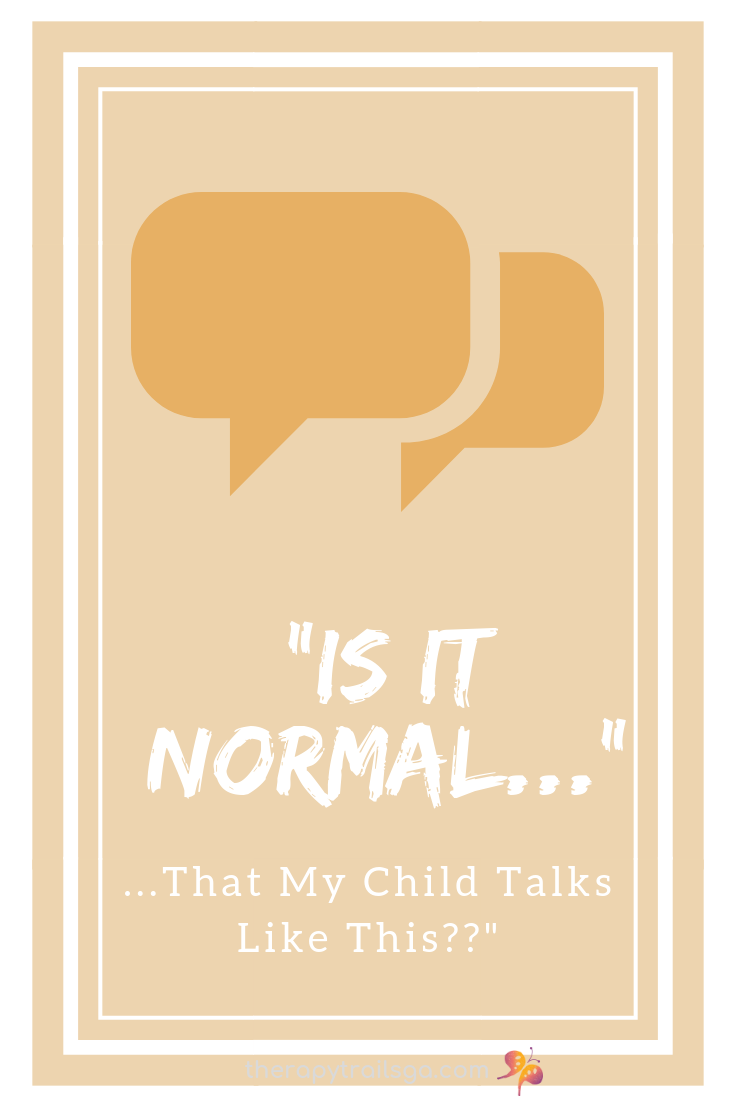Is it Normal that My Child Talks Like This?

I don’t know how this happened, but it’s already June. JUNE! Can you believe it? That means May has come-and-gone, and so has Better Speech And Hearing Month.
Coincidence that Occupational Therapy Month (April) and Better Speech And Hearing Month (May) are back-to-back? I think not. As pediatric therapists, we are frequently asked “Is this normal?” or “Will you listen/watch my child and tell me if I need an evaluation?”. Everyone asks us this, including friends, family, and everyone in-between. While often times our answers to these questions are “I think he’s fine”, sometimes there may be legitimate concerns. But how are you (as the parent, friend, cousin, or whoever) supposed to know what’s “normal” and what’s not.
First, I think we should begin by clarifying “normal”. News Alert: There is no such thing. Kids are so intricate and complex that there is no way for us to define “normal.” Not to mention the fact that all children develop at their own rate. Just ask any parent who has 2 or more kids and they will have many examples about how “… Jonah didn’t talk until he was age 2…” but “Amy was speaking at 6 months!”
So, if there is no such thing as “normal” and all children develop at different rates, how do we know if a kid needs therapy or if they will just grow out of it? Well, it’s just as tricky as it sounds. And sometimes, we don’t know 100%, but we just have to go with our gut (“mom-tuition”).
If you ever find yourself asking “Is it normal that my child talks like this?” use the following as guidelines for when (and if) you need to visit your friendly, neighborhood speech therapist!
Red Flags for Language Deficits
- Limited interaction with others at any age
- No use of babble by the age of 7 months
- Has difficulty understanding simple words and directions by 12 months
- Uses less than 20 words by the age of 18 months (Or 50 words in an ideal world!)
- Does not combine words to make a sentence by 2-years of age
Red Flags for Fluency (Stuttering)
- Late onset stuttering, which begins after the age of 4 years old
- Stuttering that does not “go away” by the time the child turns 5 years old
- There is a family history of stuttering
Red Flags for Speech Production
- Not saying “early” sounds, such as “P, B, M, H, W” by age 2
- Not saying sounds, such as “T, D, K, G, F, Y” by age 3
- Less than 50% intelligible (understood) by unfamiliar listeners by age 3
- Less than 90% intelligible (understood) by unfamiliar listeners by age 4
Alright, now what? Now that you have compared your child’s skills to the lists above, what do you do now?
Well, if you noted that your child is showing some of the signs above, I would highly recommend that you contact your local speech-language pathologist (caveat: you may have to go through your pediatrician first). Just because you noticed a red flag doesn’t mean that your child will automatically qualify to receive speech services. However, a SLP would be able to perform an in-depth evaluation and help you determine whether therapy is warranted or if you can just wait a couple of months to see how the child develops.
And as always, remember “the earlier, the better”. If a child qualifies and is able to receive speech services early on, then their expected rate of improvement is better (and possibly quicker)!
Check out the links below for more information on this topic! There is so much information and research out there that it is hard to fit it all in one blog post. 🙂
References and Additional Resources:
- “Wait and See” or “Need to See” Blog
- Speech & Language Milestones
- Speech Sound Disorders (ASHA.org)
- Signs of Speech & Language Disorders (IdentifyTheSigns.org)
- Sound Acquisition (ASHA Publications)
- Childhood Fluency Disorders (ASHA.org)
